Related Research Articles

Land Force Western Area (LFWA) was a formation of the Canadian Army responsible for operations in the Canadian provinces of Manitoba, Saskatchewan, Alberta and British Columbia. LFWA was headquartered at CFB Edmonton. The command was formed in 1991. In 2013 it was announced that LFWA would be renamed 3rd Canadian Division. This change took place in the summer of 2014.

The 5th Canadian Division is a formation of the Canadian Army responsible for the command and mobilization of most army units in the provinces of New Brunswick, Nova Scotia, Prince Edward Island and Newfoundland and Labrador; as well as some units in Kingston, Ontario. The division is recognized by the distinctive maroon patch worn on the sleeve of its soldiers.
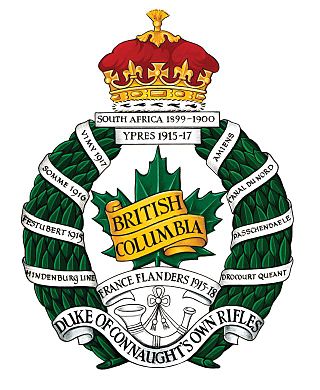
The British Columbia Regiment (Duke of Connaught's Own) is a Primary Reserve armoured reconnaissance (recce) regiment of the Canadian Army; the regiment is subordinate to 39 Canadian Brigade Group of the 3rd Canadian Division. Established in 1883, it is the oldest military unit in Vancouver, British Columbia, Canada. It parades at the Beatty Street Drill Hall at the corner of Dunsmuir and Beatty in Downtown Vancouver. The regiment has been variously designated as garrison artillery, rifles, infantry, and armoured, but has been reconnaissance since 1965. It has received 41 battle honours in its history, and has been a unit of the Royal Canadian Armoured Corps since 1942.

The Seaforth Highlanders of Canada is a Primary Reserve infantry regiment of the Canadian Army based in Vancouver, British Columbia. The regiment is subordinate to 39 Canadian Brigade Group, 3rd Canadian Division. Based at the Seaforth Armoury on Burrard Street in Vancouver, the regiment serves in both times of war and civil emergency, such as disaster relief after earthquakes or floods. It also contributes individual volunteers or "augmentees" to Canadian Forces operations around the world.

15th Field Artillery Regiment, RCA, is a Primary Reserve Royal Canadian Artillery (RCA) regiment based in Vancouver, British Columbia, at the Bessborough Armoury. 15th Field Regiment is part of the 39 Canadian Brigade Group of 3rd Canadian Division.
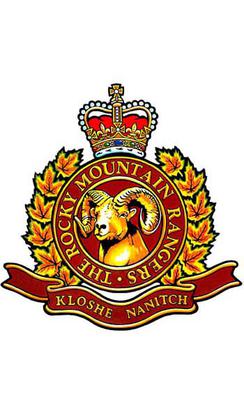
The Rocky Mountain Rangers is a Primary Reserve infantry regiment of the Canadian Army, one of only four infantry regiments in British Columbia, and the only infantry unit that recruits in Northern BC and much of the Interior. The regimental headquarters are at JR Vicars Armoury in Kamloops, with an additional rifle company in Prince George. The Rocky Mountain Rangers are part of the 3rd Canadian Division's 39 Canadian Brigade Group, the brigade responsible for Canadian Army organization in British Columbia.

The Royal Westminster Regiment is a Primary Reserve infantry regiment of the Canadian Army. It is currently part of the 3rd Canadian Division's 39 Canadian Brigade Group and is based in New Westminster, British Columbia, at The Armoury and at Colonel Roger Kenwood St. John, OMM, CD Armoury in Chilliwack, British Columbia.
41 Combat Engineer Regiment is an Army Reserve (militia) unit of the Canadian Military Engineers/Royal Canadian Engineers (RCE) in Alberta, Canada. The unit consists of:

The Canadian Military Engineers is the military engineering personnel branch of the Canadian Armed Forces. The members of the branch that wear army uniform comprise the Corps of Royal Canadian Engineers.
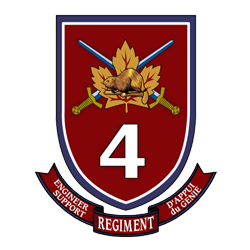
4 Engineer Support Regiment is a regiment of the Canadian Military Engineers headquartered at CFB Gagetown, New Brunswick. It is tasked to provide general engineer support to the whole of the Canadian Armed Forces.

The Primary Reserve of the Canadian Armed Forces is the first and largest of the four sub-components of the Canadian Armed Forces reserves, followed by the Supplementary Reserve, the Cadet Organizations Administration and Training Service and the Canadian Rangers.
32 Combat Engineer Regiment is the Primary Reserve unit of the Royal Canadian Engineers in Toronto, Ontario, Canada. It is assigned to 32 Canadian Brigade Group, part of 4th Canadian Division.

Canadian Forces Base Chilliwack was a Canadian Forces base located in Chilliwack, British Columbia.
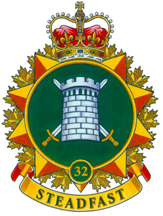
32 Canadian Brigade Group (32CBG) of the Canadian Army is part of the 4th Canadian Division. It is centred on the Greater Toronto Area, as well as Niagara Region and Brantford. It is headquartered at LCol George Taylor Denison III Armoury in Toronto, Ontario.
33 Combat Engineer Regiment (33CER) is the Primary Reserve (Militia) unit of the Canadian Military Engineers in Ottawa, Ontario, Canada. It is assigned to 33 Canadian Brigade Group, part of 4th Canadian Division.

39 Canadian Brigade Group is a Canadian Forces formation of the Canadian Army under the 3rd Canadian Division. The brigade group is composed of Canadian Forces (CF) Primary Reserve units, all of which are based within the province of British Columbia. 39 CBG Headquarters is at the Major-General B.M. Hoffmeister OC, CB, CBE, DSO Building, 1755 West 1st Avenue, Vancouver.
39 Combat Engineer Regiment was created on 3 May 2008 and amalgamated all the independent field engineer squadrons of the 39 Canadian Brigade Group in British Columbia.
Area Support Unit Chilliwack is a Canadian Forces facility located in Chilliwack, British Columbia.
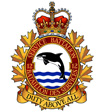
12 (Vancouver) Service Company is a Canadian Army Primary Reserve combat service support unit of the Canadian Forces that can fight in a defensive role and provides logistical support to the units within 3rd Canadian Division's 39 Canadian Brigade Group, which consists of all Primary Reserve units in British Columbia.

41 Signal Regiment is a reserve communications unit of the Royal Canadian Corps of Signals. It is part of 41 Canadian Brigade Group in Alberta. The unit consists of:
References
- ↑ "Lt. Col. James Pemberton Fell Armoury". National Defence and the Canadian Forces. Archived from the original on 7 April 2014. Retrieved 17 April 2014.